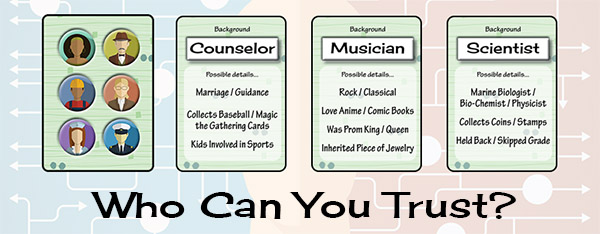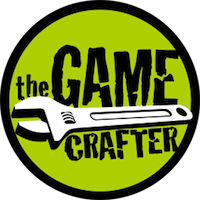


The Turing Test
Requirements
Description
In 1950, Alan Turing developed the Turing Test, meant to help distinguish between a person and a machine programmed to behave and respond like a person. Now, a new test has been developed for today's more sophisticated artificial intelligence (AI). Its creator, the Programmer, has designed the ultimate social test for their AI--a dinner party! While most of the guests are human, some of them are AI posing as human. By the end of the party, the guests attending must determine who is human and who has been programmed to act human.
Meet the Guests
In the Turing Test, players receive Backgrounds to help them assume the role of one of the party guests. Guests also receive several Traits that provide guidelines for certain Human or AI behaviors to use during the game. The guests get up and mingle, engage in conversation, ask questions, and observe each others' behavior to deduce who is AI and who is human.
Players have to follow "protocol" during conversation to remind them to weave their Traits and Background in their response. There is always at least one Artificial Intelligence in each game -- but there may be more -- so you can never fully trust anyone!

Suspicious Behavior
After mingling, each guest assigns Suspicion Tokens. These Suspicion tokens are assigned secretly, allowing humans to identify who they think is AI, while also allowing the AI to deflect attention away from themselves toward other guests.
At the end of the game, the guests who raised the most Suspicion reveal their traits to show whether they were AI or human -- if the AI guests gained the most suspicion during play, the humans win! Otherwise, the AI blended in and passed the Turing Test.
Featured Components
The Turing Test includes 38 background cards, 46 question cards, and 60 trait cards. Each card is unique, allowing for thousands of possible guest combinations. Also includes 56 Suspicion Tokens and a 12 page rulebook formatted to quickly find key rules and info. It's everything you need to play with up to 15 people.
About the Game
The Turing Test is a social game by award-winning game designer Jay Little with additional development and extensive play testing by students from the University of Wisconsin-Stout. These students contributed to the game through a special Board Game Production & Processes class Jay Little teaches at the university.
Check It Out
You can learn more about The Turing Test on Board Game Geek. Be sure to follow the page for any articles and updates. Plus, you can even download a Print and Play version of the Turing Test and try it out for yourself! Turing Test - Print & Play Edition | The Turing Test
Components
| Component | Quantity | Photo |
|---|---|---|
| Medium Pro Box | 1 |  |
| Poker Deck | 1 deck of 60 cards |  |
| Poker Deck | 1 deck of 46 cards |  |
| Poker Deck | 1 deck of 38 cards |  |
| Large Booklet | 1 |  |
| Medium Square Chit Set | 1 set of 44 medium square chits |  |
Vitals
| Average Rating | 0 reviews |
|---|---|
| Publish Date | March 05, 2018 |
| Edition | First |
| Department | Games |
| Tags | Mystery Modern / Present Party Deduction Spyfall |
| More Info | The Turing Test web site |
Why buy this?
- Deduction with storytelling, improv, and roleplay elements
- Secret identities where players may be human or AI
- Every game is different with dozens of careers and traits
Downloads
Jay Little
Notes
- This game contains laser cut components. Laser cut items will have a slight amount of soot around the edges, which can easily be wiped off; and will have a campfire smell for about a week after you open them.







